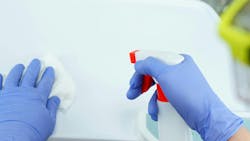Disinfectant considerations for longevity in the op
We recently noticed some of the equipment in our office is discolored, and some plastics appear worn. Even our one-year-old x-ray unit is cracking. What do you think is causing this, and what can we do to prevent further damage?
Thanks for reaching out. Offices invest a lot in their equipment, and I’m glad you are concerned with its longevity. The surface disinfectants you are using could be causing damage. While we rely on them to kill microbes, an unfortunate side effect can be equipment damage.
The perfect operatory disinfectant kills the microbes we need it to. In dentistry, that’s an EPA-registered intermediate-level disinfectant with a TB claim.1 We need it to work in a timely manner, be safe for the user, not harm our equipment or surfaces, and be affordable. But finding the perfect one for your office can be a challenge. Here are some things to consider.
Surface compatibility
If you dig into your equipment’s instructions for use (IFUs), they might recommend a specific disinfectant or a class of disinfectants. Most disinfectants on the market fall into one of three categories: quaternary ammonium compounds (quats), phenols, or peroxygen compounds. Each category has unique surface interactions depending on their concentrations and inactive ingredients. Unfortunately, while the EPA closely regulates what organism the disinfectant kills, surface compatibility is on the honor system.2
Quats are often paired with alcohol, and depending on the concentration of each, they can interact with plastics. Phenols are less used, perhaps because of their longer kill time and the residue they leave behind. Peroxygens are more environmentally friendly and less toxic to the user but tend to have a very low pH, and some report they’re more damaging to surfaces because of their high acidity.2
Standardization
It might be tempting to buy whatever is on sale, but while your accountant might love this, your equipment and team will not. If you’re looking to trim your budget, working with a manufacturer with a portfolio covering a multitude of needs to standardize your infection control protocol can open the door for contract pricing and bonus deals.
Changing products invites confusion. Standardization allows teams to feel confident in how to use the disinfectant properly. This is especially true if you have multiple offices/settings. No one wants to waste time checking the small print on the back of the canister to find out the kill time or surface compatibility (if it’s even listed). So, more than likely, it will get misused.
Give it a bath
One great way to extend the life of your equipment is to wash it with soap and water periodically to remove any residue that might build up and contribute to its destruction. This is especially important if you change disinfectants. The residue from one disinfectant can interact with the new disinfectant and discolor or damage the material (another excellent reason for standardization). So, break out the bucket and start scrubbing.
Channel your inner Goldilocks
It’s important to use the product you choose according to the instructions for use–not too much, not too little. Each disinfectant has an organism kill time, so it’s essential to consider an effective product for the organisms you are most concerned with. That could be anywhere from one to 10 minutes. This means the surface needs to stay wet (after the initial cleaning step to remove bioburden) for the entire kill time. You might have to return with multiple wipes to ensure disinfection. However, saturating a surface so it will stay wet could damage your equipment. Finding the sweet spot is essential.
Use barriers
Consider plastic barriers when it comes to equipment like your x-ray head and patient chair. Noncritical surfaces like these pose the least risk of transmission of infection. After removing the barrier, inspect the area to ensure it did not become soiled, and place a new barrier after you have performed hand hygiene. There is no need to expose the surface to a disinfectant, and it saves you precious time.1 (Note: this is not the case with semicritical devices.) They must be heat sterilized, or if they are not heat tolerant, such as x-ray sensors, use an FDA-cleared barrier and disinfect after the barrier is removed.1
Editor's note: This article appeared in the July 2024 print edition of RDH magazine. Dental hygienists in North America are eligible for a complimentary print subscription. Sign up here.
References
- Summary of infection prevention practices in dental settings: Basic expectations for safe care. Centers for Disease Control and Prevention. October 2016. Last reviewed September 10, 2021. https://www.cdc.gov/dental-infection-control/hcp/summary/index.html
- Schneiderman MT, Cartee DL. Surface disinfection. In: DePaola L, Grant L, eds. Infection Control in the Dental Office. Springer, Cham; 2019:169–191. https://doi.org/10.1007/978-3-030-30085-2_12
About the Author

Amanda Hill, BSDH, RDH, CDIPC
Amanda Hill, BSDH, RDH, CDIPC, is an enthusiastic speaker, innovative consultant, and award-winning author who brings more than 25 years of clinical dental hygiene and education to dentistry. Recipient of ADS’s Emerging Infection Control Leader award and an active participant with the advisory board for RDH magazine, DentistryIQ, and ADS’s Infection Control in Practice Editorial Review Board and membership committee, Amanda (also known as the Waterline Warrior) strives to make topics in dentistry accurate, accessible, and fun. She can be reached at [email protected].


